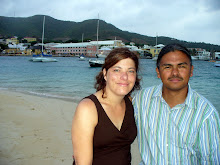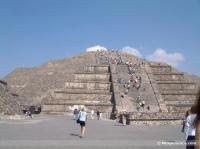 Yesterday we woke up in Puebla and did a little more sight-seeing. Our first stop was the Taller Uriarte Talavera, a pottery workshop. Talavera is a type of majolica earthenware which is glazed and fired at very high temperatures. The style originally came from Spain, but has become uniquely Pueblan. We received a tour of the factory from a man whose family has worked in the factory all 200 years it has been in existence.
Yesterday we woke up in Puebla and did a little more sight-seeing. Our first stop was the Taller Uriarte Talavera, a pottery workshop. Talavera is a type of majolica earthenware which is glazed and fired at very high temperatures. The style originally came from Spain, but has become uniquely Pueblan. We received a tour of the factory from a man whose family has worked in the factory all 200 years it has been in existence. The pottery is all hand-made and the process very labor-intensive. It takes approximately six months to make a piece. The tiles we’ve seen all over the buildings are Talavera. The tour was very interesting and the pottery is just beautiful.
The pottery is all hand-made and the process very labor-intensive. It takes approximately six months to make a piece. The tiles we’ve seen all over the buildings are Talavera. The tour was very interesting and the pottery is just beautiful.Next we went to Puebla’s Catedral, which has three organs and a large octagonal main altar. From here we wandered back through the zocalo, were Selso got a much-needed shoe-shine. Back at the hotel, we packed up and then hit the road.


We drove about 15 miles to Cholula, a city that is home to the largest pyramid ever built in Mesoamerica. Unfortunately, most of it is still buried and a church sits on top of the mound.
 We walked up to the hill to the church first – it is very pretty.
We walked up to the hill to the church first – it is very pretty.
 Next we walked through the inside of the pyramid. The kids loved this! About five miles of tunnels have been dug through the pyramid, but only a small portion of that is accessible to visitors. It was kind of spooky and we all thought it would make a great haunted house. After exiting the tunnel, we were able to see some other parts of the ruins that have been excavated.
Next we walked through the inside of the pyramid. The kids loved this! About five miles of tunnels have been dug through the pyramid, but only a small portion of that is accessible to visitors. It was kind of spooky and we all thought it would make a great haunted house. After exiting the tunnel, we were able to see some other parts of the ruins that have been excavated.
 By now it was 3:30 p.m., so we made our way to Mexico City. We spent last night in a hotel very near to where we stayed our first week here. It almost felt like coming home when we saw the familiar Parque Alameda and Palacio Bellas Artes.
By now it was 3:30 p.m., so we made our way to Mexico City. We spent last night in a hotel very near to where we stayed our first week here. It almost felt like coming home when we saw the familiar Parque Alameda and Palacio Bellas Artes.
 We walked up to the hill to the church first – it is very pretty.
We walked up to the hill to the church first – it is very pretty. Next we walked through the inside of the pyramid. The kids loved this! About five miles of tunnels have been dug through the pyramid, but only a small portion of that is accessible to visitors. It was kind of spooky and we all thought it would make a great haunted house. After exiting the tunnel, we were able to see some other parts of the ruins that have been excavated.
Next we walked through the inside of the pyramid. The kids loved this! About five miles of tunnels have been dug through the pyramid, but only a small portion of that is accessible to visitors. It was kind of spooky and we all thought it would make a great haunted house. After exiting the tunnel, we were able to see some other parts of the ruins that have been excavated. By now it was 3:30 p.m., so we made our way to Mexico City. We spent last night in a hotel very near to where we stayed our first week here. It almost felt like coming home when we saw the familiar Parque Alameda and Palacio Bellas Artes.
By now it was 3:30 p.m., so we made our way to Mexico City. We spent last night in a hotel very near to where we stayed our first week here. It almost felt like coming home when we saw the familiar Parque Alameda and Palacio Bellas Artes. This morning we couldn’t resist breakfast at Café El Popular (I had an amazing omelet there our first week that I’ve been dreaming about since) and one last look at the Diego Rivera murals at the Palacio Nacional.


















 From here we checked out Zaachila’s market – this village has it all! It was more of the same, but we enjoyed it. We picked up some empanadas for lunch, which turned out to have pig brain filling. I had no idea, and they were pretty tasty.
From here we checked out Zaachila’s market – this village has it all! It was more of the same, but we enjoyed it. We picked up some empanadas for lunch, which turned out to have pig brain filling. I had no idea, and they were pretty tasty.










 The ex-convent is a beautiful building, with several patios and lovely halls.
The ex-convent is a beautiful building, with several patios and lovely halls.




 When we arrived back at my parents’ hotel, we heard about the fun activities of their day (the highlight being a trip to get ice cream). We visited for a bit, and around 6:30 left to find dinner. We ate a delicious meal (Selso and I both had mole Amarillo) at Casa de la Abuela (see view from our table, above).
When we arrived back at my parents’ hotel, we heard about the fun activities of their day (the highlight being a trip to get ice cream). We visited for a bit, and around 6:30 left to find dinner. We ate a delicious meal (Selso and I both had mole Amarillo) at Casa de la Abuela (see view from our table, above).






